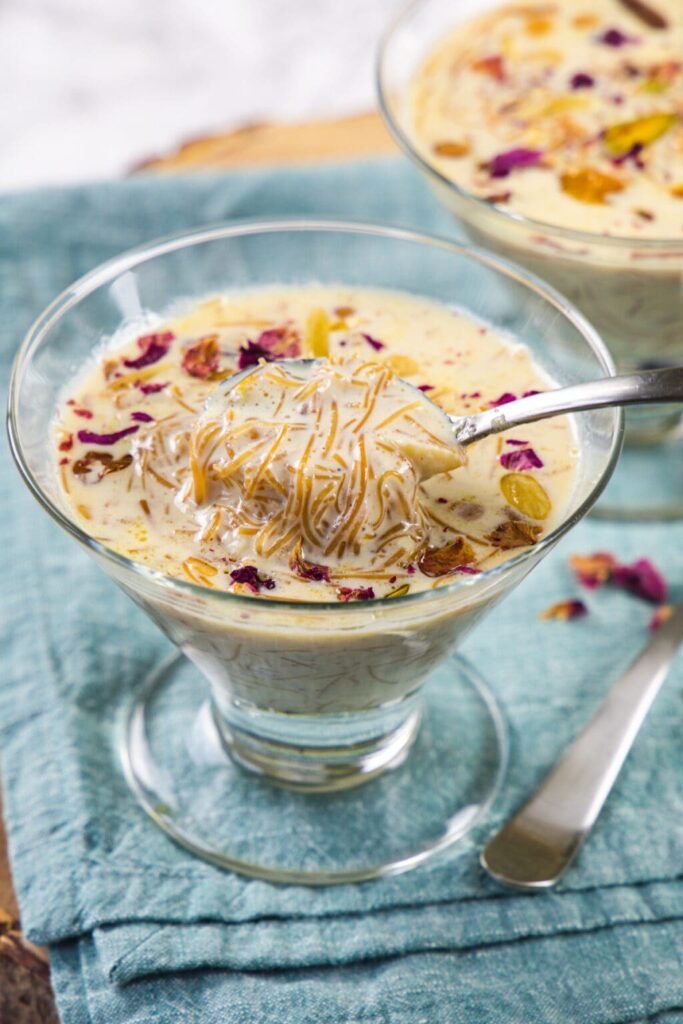Sheer Khurma is a rich, traditional dessert specially made to celebrate Eid ul-Fitr, the joyous festival that marks the end of Ramadan. This rich, creamy delicacy is a cherished part of Eid celebrations across many Muslim households.
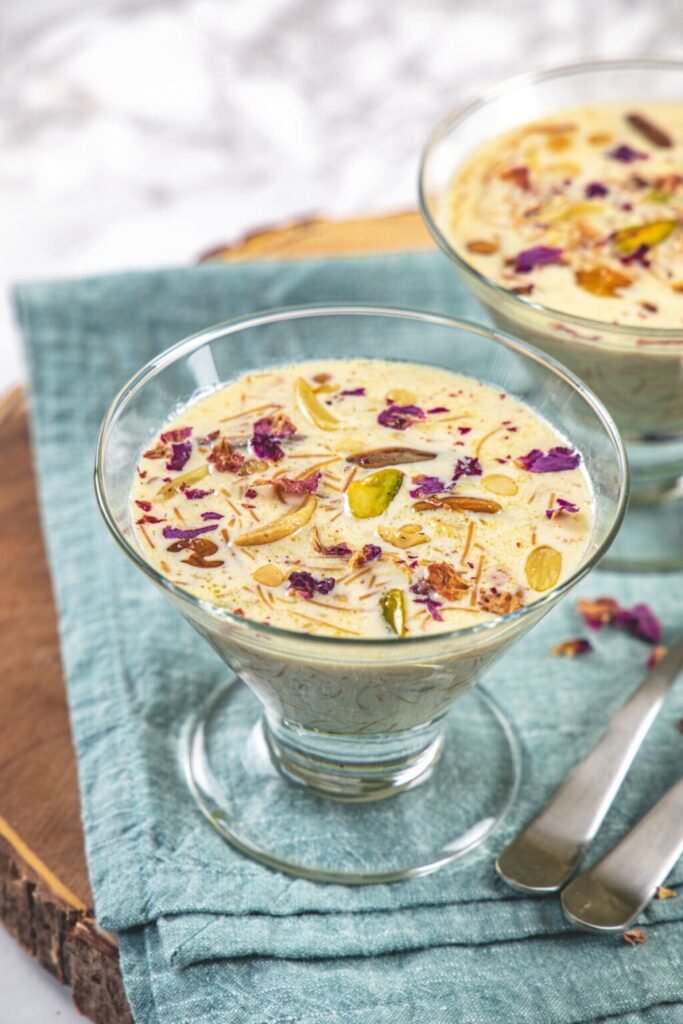
Sheer Khurma, meaning “milk with dates,” combines thin vermicelli simmered in full-fat milk, sweetened gently, and infused with cardamom and saffron.
What makes sheer khurma truly special is its lavish use of ghee-toasted nuts and dried fruits—like almonds, pistachios, cashews, and golden raisins—combined with tender, juicy dates. These dates not only reflect their cultural and religious importance during Ramadan but also add a rich, natural sweetness that enhances the overall flavor. These ingredients are roasted in pure ghee until golden and aromatic, then folded into the simmering milk and vermicelli mixture, creating a rich tapestry of textures and flavors.
As the mixture gently thickens on the stove, it transforms into a decadent, milky dessert that is both soothing and celebratory. The addition of saffron gives it a beautiful golden hue, while the crushed cardamom adds a warm, floral fragrance that lingers with every spoonful.
Sheer khurma is typically served warm, straight from the pot, offering a cozy and comforting experience, though it can also be enjoyed slightly chilled if preferred. Whether served to guests during Eid morning or shared among loved ones throughout the festive day, this dish holds a special place in the hearts of many. It’s more than just a dessert—it’s a symbol of tradition, hospitality, and joyous gatherings. A must-make treat to mark the sweetness of Eid and the love of togetherness.
What Is Sheer Khurma?
In the Persian language, “sheer” stands for milk, and “khurma” denotes dates. This cherished festive dish carries cultural importance and is popularly prepared in countries like India, Pakistan, Bangladesh, and Afghanistan.
Sheer Khurma is a classic festive dessert made especially for Eid al-Fitr, which marks the conclusion of the sacred month of Ramadan. It’s a dish found in nearly every Muslim household during this time, often made in generous batches to share with friends, neighbors, and extended family as part of the joyful festivities.
While the core ingredients remain the same—milk, dates, vermicelli, and nuts—each family adds its own unique touch. Some include khoya for richness, others may use cream or condensed milk to make it more indulgent. These small variations create delightful differences in flavor and texture across regions and households.
Traditionally, sheer khurma is enjoyed as a special Eid breakfast after the morning prayers, symbolizing the beginning of a day filled with blessings and togetherness. It is also offered to guests throughout the day, often served warm or chilled depending on personal preference and the weather.
This dessert isn’t just a sweet treat—it’s a beautiful expression of hospitality, tradition, and the warmth of celebration.
Ingredient Notes:

- Milk: Use full-fat whole milk for a rich, creamy consistency that defines traditional sheer khurma. Low-fat milk simply can’t deliver the same indulgent texture.
- Nuts: Traditionally, almonds, cashews, and pistachios are used. Roast the nuts in ghee for deep flavor, or blanch and slice them for a delicate, elegant touch.
- Chironji Seeds (Charoli): These tiny, nutty seeds add a unique crunch. Easily found in Indian grocery stores, they spoil quickly, so refrigerate them in an airtight container.
- Raisins: Golden raisins add sweetness and vibrant color. When sautéed in ghee, they swell up and turn juicy, adding texture to every spoonful.
- Dried Dates (Kharek/Chuara): Chopped dried dates are soaked before use. You can also use soft Medjool dates as a quicker, equally delicious alternative.
- Thin Vermicelli (Seviyan): Choose roasted, extra-thin vermicelli for the perfect texture. Avoid thicker types used in South Indian payasam. Trusted brands include National and Shan.
- Ghee: Ghee not only toasts the dry fruits but also infuses the dessert with a warm, nutty aroma that’s deeply comforting.
- Sweetened Condensed Milk: This cuts down cooking time and adds instant richness and sweetness, giving the dish a velvety finish.
- Cardamom Powder: Freshly crush green cardamom seeds for a rich, aromatic flavor. Skip pre-ground versions for a more vibrant flavor.
- Saffron: Soak saffron strands in warm milk to infuse the dessert with vibrant color and a delicate floral aroma.
- Optional: Add rose water or kewra water for a floral note, but avoid using both with saffron to prevent flavor clashes.
How To Make Sheer Khurma?
1) In separate bowls, soak almonds, cashews, and pistachios in enough water so that the water level is about ½ inch above the nuts. Similarly, place chironji seeds and dried dates in separate bowls and soak them in enough water to soften overnight. Cover all the bowls and let them sit overnight.
Why soak? Nuts and dry fruits are traditionally believed to have a warming effect on the body, often referred to as “garam taseer.” Soaking them overnight helps reduce this heat, making them easier on the stomach, especially important after a month of fasting during Ramadan. Also, soaking hard dried dates softens them, making them easier to chop and digest.
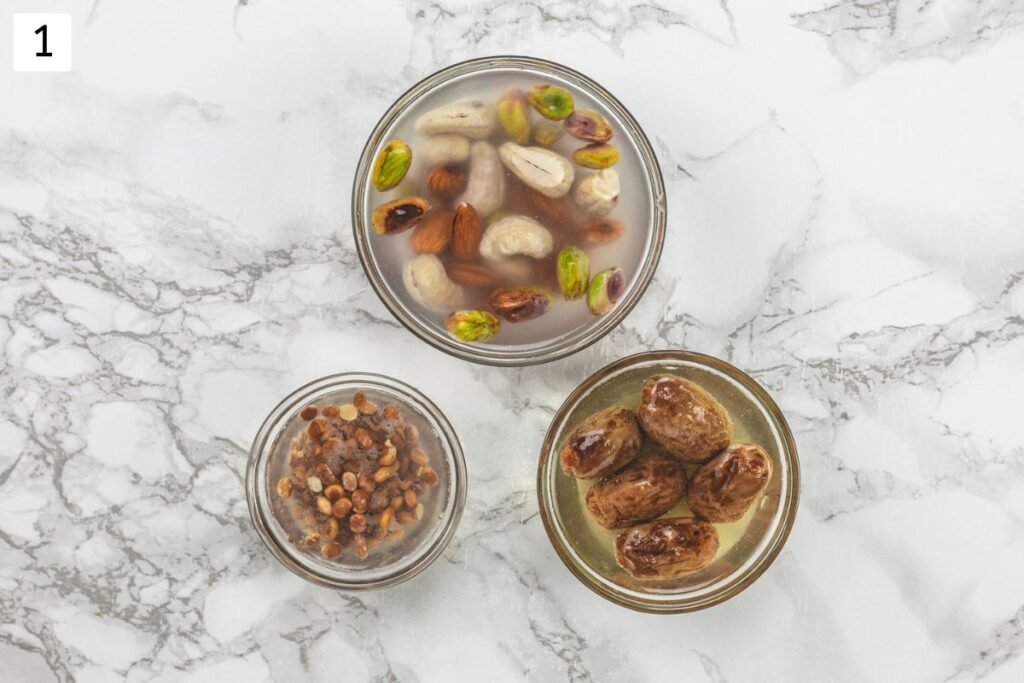
2) The next morning, peel the skins off the soaked almonds and pistachios, then thinly slice the almonds, cashews, and pistachios. Set aside.

3) For chironji, rub the seeds gently between your thumb and fingers to loosen and remove the skin. Though it takes some time, this step enhances texture and flavor.

4) With the dried dates, use a sharp knife to open each one, discard the seeds, and slice them thinly for even distribution throughout the dessert.

Making Sheer Khurma:
1) In a heavy-bottomed pan, pour the full-fat milk and bring it to a gentle boil over medium heat.
2) Once it reaches a boil, lower the heat slightly and simmer for about 10 minutes, stirring every few minutes to prevent it from sticking or burning. As the milk reduces, scrape the sides of the pan to mix in the thickened cream for added richness.
3) Meanwhile, soak a pinch of saffron strands in 2 tablespoons of warm milk to release their vibrant color and delicate fragrance. Let it soak to release its vibrant color and aroma.
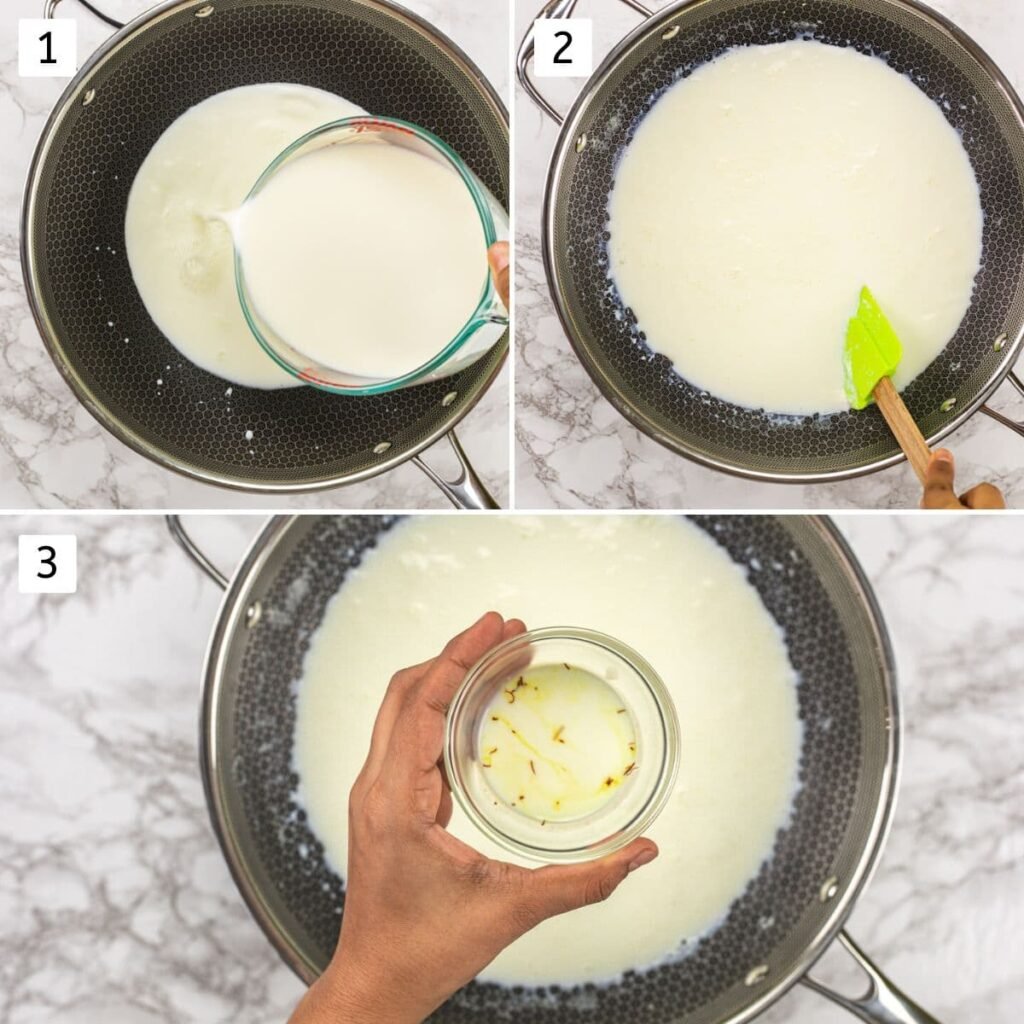
4) In a separate wide pan, heat 2 tablespoons of ghee on medium heat. When the ghee is hot, toss in the sliced nuts and chironji seeds and let them roast gently.
5) Roast for 3–4 minutes, stirring continuously until they turn aromatic and slightly golden—avoid letting them brown.
6) Next, add the golden raisins and thinly sliced dried dates to the same pan.
7) Continue roasting for another 1–2 minutes, just until the raisins puff up and the dates release their aroma.
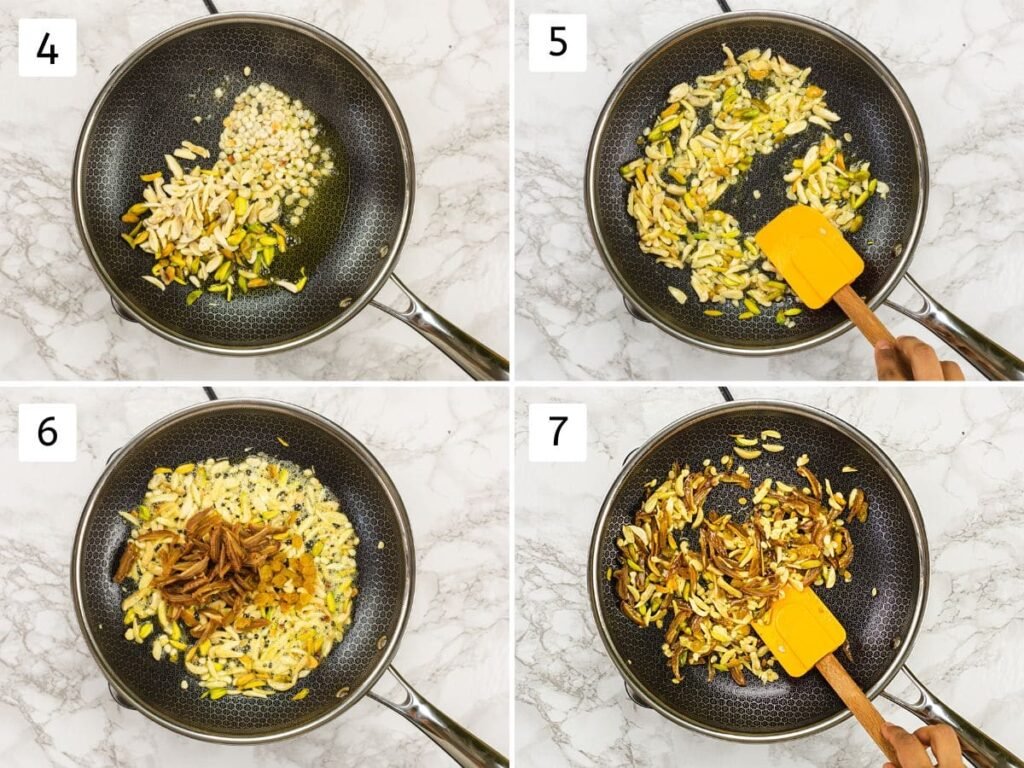
8) Pour the roasted nuts and dried fruits into the simmering milk. Mix gently so the flavors infuse evenly throughout the dessert.

9) Using the same pan, pour in the remaining 2 tablespoons of ghee and heat it over medium flame. Once hot, add the vermicelli (break into 1–2 inch pieces for even texture).
10) Roast the vermicelli over medium heat, stirring constantly.
11) Keep roasting until it turns a golden brown color. Be cautious, as thin vermicelli browns quickly—lower the heat if necessary.
12) Add the roasted vermicelli along with all the ghee into the milk. Simmer the mixture for 2–3 minutes. The fine vermicelli cooks very quickly.
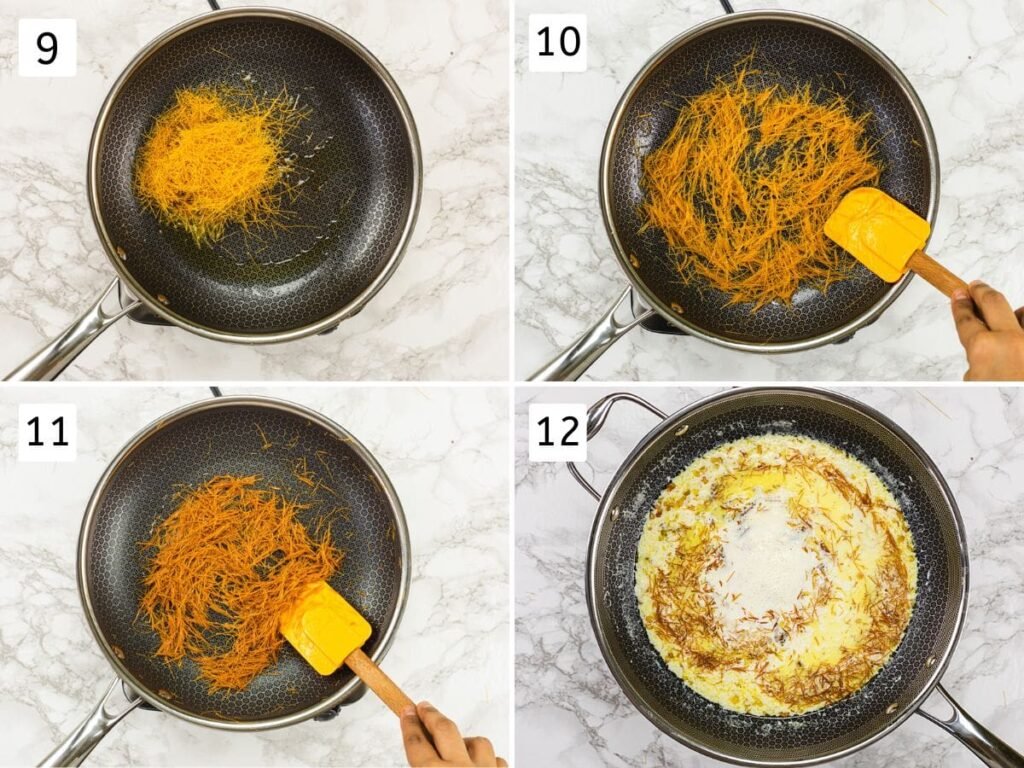
13) Now, pour in the condensed milk, which adds sweetness and helps thicken the mixture.
14) Add the cardamom powder for that warm, fragrant aroma.
15) Stir in the saffron-infused milk to impart a beautiful color and mild floral flavor.
16) Let everything simmer gently for about 10 minutes, stirring regularly.
17) As it simmers, the mixture gradually thickens, developing a rich and creamy consistency. You’ll notice the ghee on top will slowly emulsify and blend into the mixture, giving it a luxurious finish.
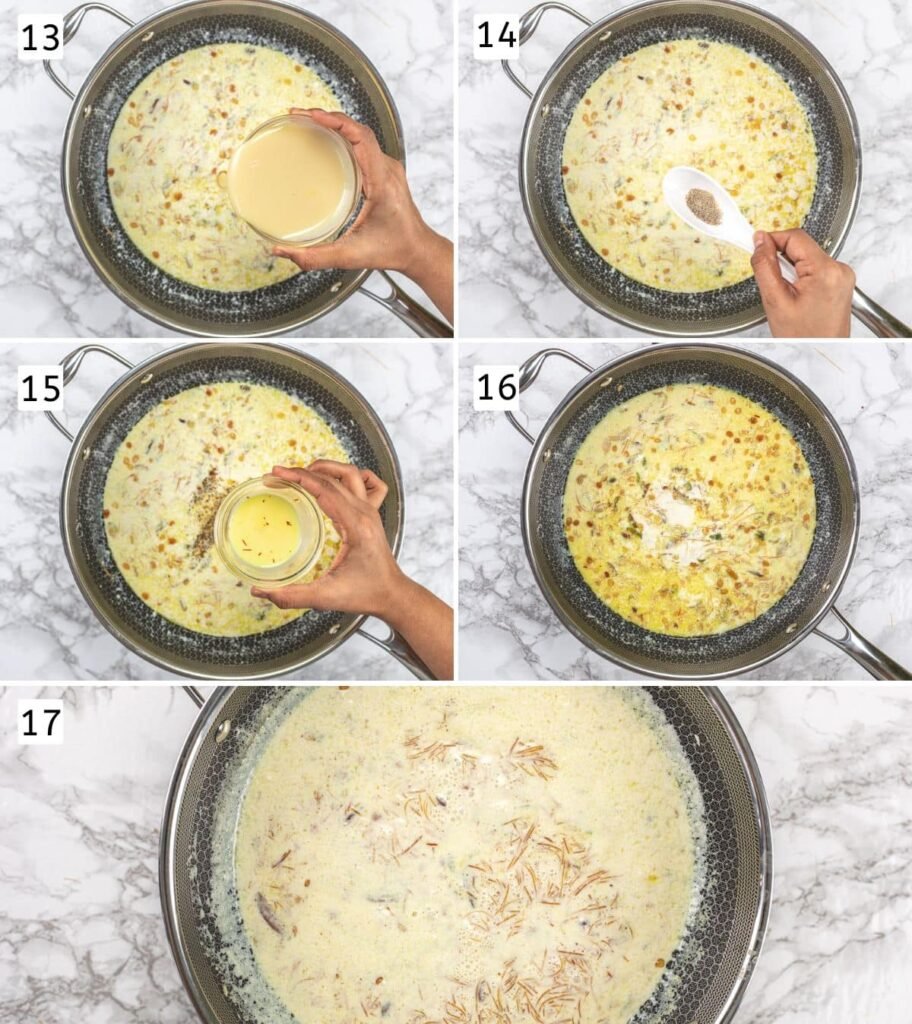
18) Enjoy Sheer Khurma warm, at room temperature, or chilled—serve it the way you love most. Remember, as it cools, the dessert thickens further, making the texture even more decadent and pudding-like.
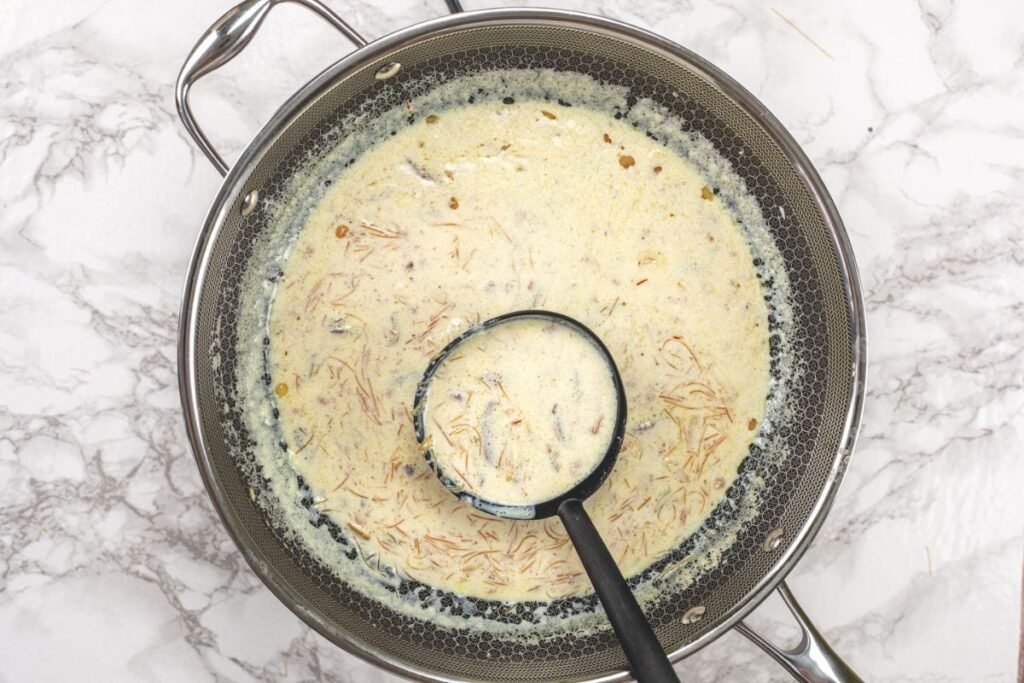
Expert Tips For the Best Sheer Khurma
1) Forgot to soak the nuts and dried dates overnight?
Don’t worry—there’s a quicker method to save the day. If you missed soaking them the night before, simply soak the nuts and dried dates in boiling hot water for about 30 minutes. This softens them enough for slicing and cooking. However, soaking overnight is still the better option, especially after Ramadan, as it neutralizes the natural “garam taseer” (warming effect) of dry fruits, making them easier on the stomach.
2) Don’t have dried dates on hand, or don’t want to buy them just for one recipe?
No problem! You can easily replace dried dates with fresh Medjool dates, which are soft, sweet, and readily available. The bonus? No soaking required—just deseed, slice, and use directly. However, keep in mind that dried dates contribute a chewy texture and deeper flavor, which are signature characteristics of traditional Sheer Khurma.
3) Adjusting the consistency—warm vs chilled:
As Sheer Khurma cools, especially after refrigeration, it naturally thickens due to the vermicelli and dry fruits absorbing more liquid. If you’re planning to serve it chilled, keep the mixture slightly thinner during the cooking process. On the other hand, if serving it warm and freshly made, you can let it simmer a little longer to achieve a thicker, creamier texture. Either way, monitor the consistency based on how you plan to enjoy it.
